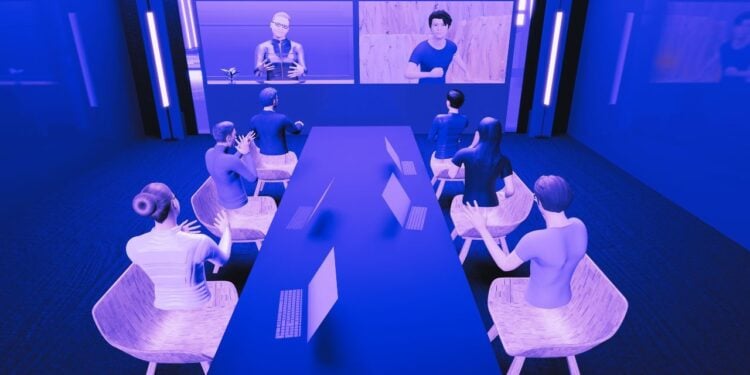- Virtual and augmented reality technologies are emerging to bridge the gap between physical isolation and collaborative teamwork, creating immersive environments that mimic real-world office interactions.
- Synthesized environments enhance presence and interaction quality but pose challenges such as cognitive dissonance, miscommunication, and the need to balance virtual exposure with real-world interactions.
- Ensuring equitable access to VR/AR technologies is important in preventing a divided workforce, while striking a balanced approach to integrate these tools mindfully to nurture genuine and supportive remote work cultures.
A quarter of remote workers say that they’re lonely — underscoring the urgent need for innovative solutions.
The swift transition to remote work, accelerated by global disruptions, has highlighted both the opportunities and challenges of our interconnected society.
As businesses seek innovative ways to help team cohesion, reduce the isolation often associated with remote work, and maintain overall productivity, virtual and augmented reality (VR/AR) technologies are beginning to surface as key players.
By creating synthetic environments that can closely mimic physical offices, these technologies hold the potential to transform how we work, interact, and connect.
However, the psychological and social ramifications of such interactions warrant rigorous exploration and understanding.
Synthesizing Physical and Virtual Workspace
Virtual and augmented reality technologies bridge the gap between physical isolation and collective collaboration. VR offers fully immersive environments that simulate real-world office settings, allowing colleagues to share space, experience presence, and perform collaborative tasks as if they were physically together.
AR, on the other hand, overlays digital information on the real world, enabling remote workers to interact with both physical and digital objects seamlessly.
Psychological and Social Implications
One of the most profound psychological aspects of these synthesized environments is the concept of presence.
In a well-crafted synthetic environment, users can experience a sense of “being there,” significantly enhancing the quality of remote interactions. This presence not only pertains to the environment but also to the embodiment of avatars, but discrepancies between a person’s physical self and their avatar can create cognitive dissonance and impact self-perception.
Communication nuances also need to be considered, as non-verbal cues, such as body language, facial expressions, and eye contact, constitute a large part of human communication. VR and AR environments aim to capture and transmit these subtle signals to advocate for more nuanced and effective interactions.
However, current technology still grapples with accurately rendering these cues in real-time. Miscommunication and depersonalization risks arise when these cues are inadequately replicated.
Confusingly, synthetic environments offer a canvas for self-representation that can be both liberating and constraining.
On one hand, avatars can enable users to express their identity in ways not possible in the physical realm. On the other hand, they may enforce uniformity or exacerbate issues of identity dissonance and anonymity, impacting trust and authenticity within teams.
The immersive nature of VR can help alleviate feelings of isolation by creating a sense of community. But, constant exposure to synthetic environments may lead to mental fatigue, sometimes referred to as “cybersickness,” and may adversely affect mental health if not balanced with real-world interactions. It is imperative to monitor these aspects to ensure the well-being of remote workers.
The Digital Divide
Access to VR and AR technologies introduces a significant variable in the equation — unequal access. High-quality VR/AR setups are expensive and require robust internet connectivity, which may not be universally available.
This digital divide can make existing inequalities worse, creating a two-tiered work environment where some employees are afforded enhanced interaction and others are left behind. Ensuring equitable access to these technologies is essential to avoid deepening divides within the workforce.
Balancing Innovation and Risk
Embracing synthetic work environments can lead to innovative communication methods, breaking down geographical barriers and creating a more inclusive global workforce. These technologies can be particularly beneficial for specialized training, simulation exercises, and creativity-boosting activities.
While synthetic environments can simulate physical spaces, there is an inherent risk of depersonalization if interactions become overly mechanized or transactional. The human element of empathy, spontaneity, and serendipity in interactions stands at risk if technology is over-relied upon without mindful integration into organizational culture.
At the cusp of synthetic work environments, a balanced and reflective strategy is essential. Collaboration between businesses and technology developers is needed to improve the authenticity of virtual interactions, making them as significant and genuine as in-person meetings. Simultaneously, initiatives should focus on making VR/AR technologies broadly accessible to avoid creating a divided workforce.
In traversing this delicate balance between innovation and human connection, the future of work can harness VR and AR to not only simulate physical office environments but also nurture a supportive, cohesive, and inclusive remote work culture.
If workplace leaders address the psychological, social, and access-related challenges head-on, synthetic relationships can flourish, paving the way for a seamlessly integrated hybrid work ecosystem.


 Dr. Gleb Tsipursky – The Office Whisperer
Dr. Gleb Tsipursky – The Office Whisperer Nirit Cohen – WorkFutures
Nirit Cohen – WorkFutures Angela Howard – Culture Expert
Angela Howard – Culture Expert Drew Jones – Design & Innovation
Drew Jones – Design & Innovation Jonathan Price – CRE & Flex Expert
Jonathan Price – CRE & Flex Expert













